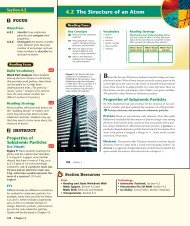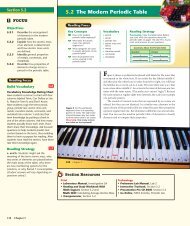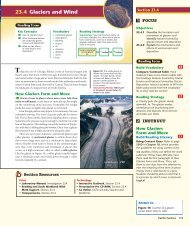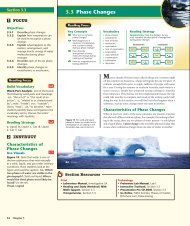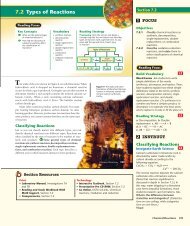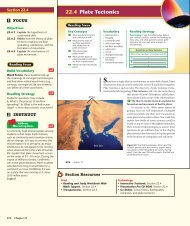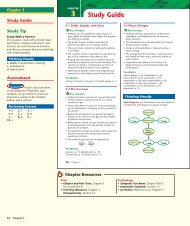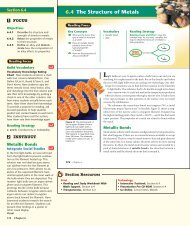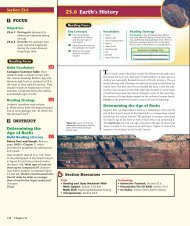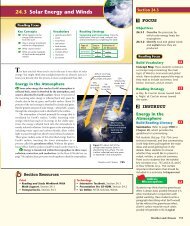26.2 Stars
26.2 Stars
26.2 Stars
You also want an ePaper? Increase the reach of your titles
YUMPU automatically turns print PDFs into web optimized ePapers that Google loves.
Earth in<br />
January<br />
Parallax <strong>Stars</strong> are so far away that astronomers cannot measure<br />
their distances directly. Astronomers have developed various methods<br />
of determining the distances to stars. Different methods are used for<br />
stars at different distances.<br />
To understand how astronomers can measure distances to nearby<br />
stars, hold your thumb up at arm’s length in front of you, as the student<br />
is doing in Figure 9. Close your left eye and look at your thumb<br />
with just your right eye open. Then cover your right eye and look with<br />
just your left eye open. Even though you didn’t move your thumb, it<br />
appeared to move relative to the background because you looked at it<br />
from slightly different angles. The apparent change in position of an<br />
object with respect to a distant background is called parallax.<br />
As Earth moves in its orbit, astronomers are able to observe stars from<br />
two different positions. Imagine looking at the stars in winter and then<br />
six months later in summer. During this time, Earth has moved from one<br />
side of its orbit to the other—a distance of about 300 million kilometers.<br />
Because people on Earth are looking from a different angle, the nearby<br />
star appears to move against the more-distant background stars.<br />
Before the invention of the telescope, astronomers couldn’t measure<br />
a star’s position very accurately. They couldn’t detect the apparent<br />
movement of even a single nearby star as Earth moved around the sun.<br />
With the invention of the telescope, astronomers could measure<br />
the positions of stars with much greater accuracy. Astronomers<br />
measure the parallax of nearby stars to determine their distance<br />
from Earth. The closer a star is to Earth, the greater is its parallax.<br />
Customize for Inclusion Students<br />
Learning Disabled<br />
Inspire confidence in learning-disabled students<br />
by beginning each new topic with a question<br />
or activity that they can successfully master. For<br />
example, you could start this section by asking<br />
Nearby star<br />
Sun<br />
Earth’s orbit<br />
Distant stars<br />
Earth in<br />
July<br />
Figure 9 You can observe<br />
parallax by holding your thumb in<br />
front of you. Compare its<br />
positions when you look at it first<br />
with one eye and then with the<br />
other. Astronomers can measure<br />
the parallax of nearby stars by<br />
measuring their position relative<br />
to distant stars as the Earth<br />
revolves around the sun.<br />
Observing Is the parallax of your<br />
thumb greater when it is closer to<br />
your eyes or when it is farther<br />
from your eyes?<br />
Exploring the Universe 835<br />
students to describe the night sky. Or, you<br />
could ask them to calculate their age when<br />
light from Proxima Centauri left the star. Simply<br />
say, Light left the star more than four years<br />
ago. How old were you then?<br />
Build Math Skills<br />
Exponents: Multiplication and<br />
Division Have students practice working<br />
with exponents by comparing the<br />
light-year to the AU. Ask them to write<br />
9.46 trillion km (one light-year) in<br />
exponential form. (9.46 1012 km)<br />
Remind students that the average<br />
distance from Earth to the sun is<br />
149,598,000 km (one AU). Have them<br />
write this number in exponential form.<br />
(1.496 108 km) Then, have students<br />
divide the numbers to determine<br />
how many AU equal one light-year.<br />
([9.46 1012 km/light-year]/[1.496 <br />
108 km/AU] 63,200 AU/light-year)<br />
Logical<br />
Direct students to the Math Skills in<br />
the Skills and Reference Handbook<br />
at the end of the student text for<br />
additional help.<br />
Use Visuals<br />
Figure 9 Tell students that even the<br />
largest measured parallax of a star is less<br />
than the apparent width of a dime at a<br />
distance of a mile. It is much too small to<br />
be seen with the unaided eye. Ask, Why<br />
does the star appear to move? (Earth<br />
has moved from one side of its orbit to the<br />
other. An observer on Earth is viewing the<br />
star from a different angle.) What do the<br />
arrows show? (The angle of sight of an<br />
observer on Earth)<br />
Visual<br />
Build Science Skills<br />
L1<br />
L1<br />
L2<br />
Calculating Explain that parallax is<br />
typically measured in arc-seconds, a unit<br />
equal to 1/3600 of a degree. A star could<br />
have a parallax, for example, of 1 arc-sec,<br />
abbreviated as 1". A parsec is a unit of<br />
measure equal to the distance at which<br />
a star’s parallax is 1 arc-second. One<br />
parsec is equal to 3.26 light-years. The<br />
following formula is used to calculate<br />
the distance of a star in parsecs: d 1/p<br />
where d represents distance in parsecs<br />
and p represents parallax in arc-seconds.<br />
Write the formula on the board and have<br />
students calculate the distance to a star<br />
that has a parallax of 0.20". (1/0.20" <br />
5.0 parsecs) Then, ask students to convert<br />
this distance to light-years. (5.0 parsecs <br />
3.26 light-years/parsec 16 light-years)<br />
Logical<br />
Answer to . . .<br />
Figure 9 When it is closer to your eyes<br />
Exploring the Universe 835



